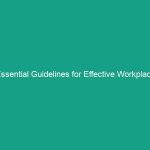Introduction
Good morning team! Today, we’re going to talk about an important topic that affects us all during the warmer months: working in hot weather. As you know, temperatures can rise significantly, making it crucial to understand how to stay safe and productive while doing our jobs. The guidelines we discuss today will help ensure your health and Safety, so you can focus on your tasks without added stress.
Understanding Essential Guidelines for Working in Hot Weather
The phrase “Essential Guidelines for Working in Hot Weather” refers to a set of practices designed to protect employees from heat-related illnesses while maintaining productivity. As temperatures soar, the risk of heat exhaustion and heat stroke increases, which can have serious consequences on your health and work performance. It’s a common misconception that you can simply power through the heat; however, ignoring the signs of heat stress can lead to dangerous situations.
Key Hazards, Risks, and Safety Considerations
When working in hot weather, several specific Hazards and risks come into play:
- Heat Exhaustion: Symptoms include heavy sweating, weakness, dizziness, and headache.
- Heat Stroke: A more severe condition that can cause confusion, loss of consciousness, and even death.
- Dehydration: Lack of adequate fluid intake can lead to reduced performance and serious health issues.
- Sunburn: Prolonged exposure to the sun can damage the skin and increase the risk of skin cancer.
Ignoring these risks can lead to real-world consequences, such as hospital visits, decreased productivity, and even long-term health issues. It’s essential to recognize these hazards and take proactive measures to mitigate them.
Best Practices, Procedures, & Actionable Advice
Here are some Best Practices and actionable steps you can take to stay safe while working in the heat:
1. Stay Hydrated
Drink plenty of water before, during, and after work. Aim for at least 8 ounces of water every 20-30 minutes while working in hot conditions.
2. Wear Appropriate Clothing
Choose lightweight, loose-fitting, and light-colored clothing to help keep your body cool. A wide-brimmed hat can also protect you from direct sunlight.
3. Take Regular Breaks
Schedule breaks in shaded or air-conditioned areas to allow your body to cool down. Remember, taking breaks can actually enhance your productivity!
4. Recognize the Signs of Heat Stress
Be aware of the symptoms of heat exhaustion and heat stroke. If you or a coworker shows signs of heat stress, take immediate action:
- Move to a cooler place.
- Drink water or a sports drink.
- Apply cool, wet cloths to the body.
- Seek medical attention if symptoms persist.
5. Plan Work Hours Wisely
If possible, schedule strenuous tasks for cooler parts of the day, such as early morning or late afternoon.
6. Use Fans and Cooling Devices
Utilize fans, misting devices, or portable air conditioning units to help regulate the temperature in your work area.
Case Study: Heat-Related Incident
Let’s consider a real-world example. Last summer, a crew working outside during peak heat hours experienced a case of heat exhaustion. One worker exhibited signs of severe fatigue and dizziness but continued to push through. They eventually collapsed and required medical attention. This incident serves as a reminder of the importance of adhering to heat Safety Guidelines and recognizing when to take a break.
Regulations, Standards, and Compliance
It’s important to be aware of safety Regulations related to working in hot weather. OSHA (Occupational Safety and Health Administration) has guidelines that outline the responsibilities of employers to provide a safe working Environment, which includes:
- Implementing a Heat Illness Prevention program.
- Training employees about the risks of heat-related illnesses.
- Monitoring weather conditions and adjusting work practices accordingly.
Compliance with these regulations is critical not just for legal reasons, but for the overall health and safety of all employees. By following these guidelines, we can protect ourselves and our coworkers from serious health risks.
Employee Engagement & Discussion
Now that we’ve gone over these essential guidelines, let’s open the floor for discussion. Here are a few questions to consider:
- What safety challenges have you encountered related to working in hot weather?
- How do you ensure you stay hydrated during your shifts?
- What additional measures do you think we could implement to improve safety in high temperatures?
Your experiences and insights are invaluable in creating a safer workplace for everyone.
Conclusion & Key Takeaways
In summary, working in hot weather presents unique challenges that we must address to ensure our safety and productivity. Remember to stay hydrated, wear appropriate clothing, take breaks, recognize the signs of heat stress, and comply with safety regulations. By applying these practices, you not only safeguard your health but also contribute to a more productive work environment.
Thank you all for your attention today. Let’s prioritize safety and look out for one another as we navigate the heat. Stay safe and productive!


